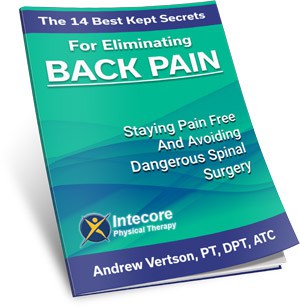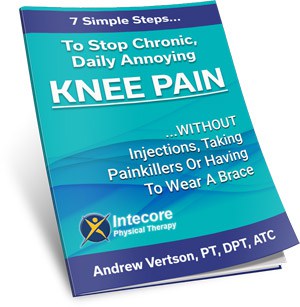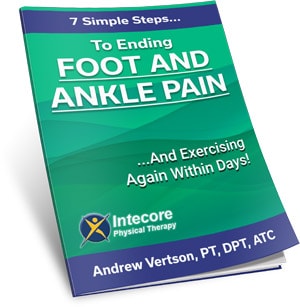
Pain between shoulder blades can feel like an unwelcome guest that overstays its welcome, turning every movement into a reminder of its presence. Whether it creeps up on you during a long day at the desk or announces itself with a sharp jolt after a workout, this type of discomfort is incredibly frustrating.
Many of us brush it off as just another part of life’s aches and pains, but have you ever stopped to wonder what causes pain between the shoulder blades? This nagging question leads us down a path of exploration, through the intricate world of our back’s anatomy and the various culprits behind the discomfort.
More Posts Like This By Intecore PT:
What Is The Difference Between Sciatica and Piriformis Syndrome?
Experience Lasting Relief: 5 Proven Strategies for Lower Back and Hip Pain
How To Sleep with Sciatica and Back Pain
Table of Contents
Why Does Pain Between Shoulder Blades Happen?
The area between the shoulder blades, also known as the thoracic spine region, is a complex network of bones, muscles, tendons, and ligaments that work in harmony to support the upper body and facilitate a wide range of movements. This central hub of activity is crucial for everything from lifting and reaching to twisting and bending, playing a pivotal role in overall back and shoulder health.
Causes of pain between the shoulder blades can arise from this intricate interplay of structures, often reflecting the stress and strain of daily life. The muscles in this area, including the rhomboids and trapezius, are particularly susceptible to tension and overuse. Whether it’s from hunching over a computer, carrying heavy loads, or engaging in repetitive motions, these activities can lead to discomfort that resonates through the thoracic spine.
Furthermore, the thoracic spine itself, with its vertebrae and interconnecting joints, can be a source of pain. Issues like poor posture can alter the natural alignment of the spine, placing undue pressure on the discs and joints, leading to inflammation, irritation, or even degenerative changes over time.
Understanding that pain between the shoulder blades is not just a simple muscle ache but a signal from a complex system of interconnected components highlights the importance of addressing and treating this discomfort with care. Recognizing the multifaceted nature of this pain is the first step toward effective management and relief.
Common Causes of Pain Between Shoulder Blades
Muscle Strain: A primary culprit for pain between shoulder blades is muscle strain. This can occur through overuse, such as engaging in repetitive movements during sports or work activities, or through improper use, like lifting heavy objects incorrectly. The muscles and tendons in the upper back are stretched beyond their capacity, leading to micro-tears and inflammation. This type of strain not only causes immediate pain but can also lead to chronic discomfort if not properly addressed.
Poor Posture: Our modern lifestyles contribute significantly to the development of poor posture, a key factor in back pain between your shoulder blades. Prolonged periods of sitting, especially with hunched shoulders over a computer or smartphone, can strain the muscles and ligaments in the upper back. Over time, this constant strain can alter the natural curve of the spine, leading to stiffness, discomfort, and decreased mobility.
Spinal Issues: The spine is the backbone of our body’s structure, and issues within it can manifest as pain in various locations, including pain between shoulder blades. Conditions such as herniated discs, where the cushioning between the spinal vertebrae protrudes and irritates nearby nerves, or osteoarthritis, a degenerative disease that affects the joints in the spine, can cause significant discomfort in this region. These spinal issues can lead to a dull, aching pain or sharp, shooting sensations, depending on the nerves affected.
Other Medical Conditions: While musculoskeletal issues are often behind pain between shoulder blades, it’s crucial to be aware that other medical conditions can also manifest this way. For instance, gallbladder disease can cause referred pain to the upper back, as can certain heart conditions, including pericarditis or, in rare cases, a heart attack. These examples highlight the importance of a professional evaluation, especially if the pain is sudden, severe, or accompanied by other symptoms like shortness of breath or gastrointestinal distress.
How Physical Therapy Can Help
Physical therapists are like detectives for body pain. They start by getting to the root of your discomfort, using their expertise to diagnose the cause of your pain between the shoulder blades.
Once the root of cause pain between shoulder blades, they design a plan tailored for you. This isn’t a one-size-fits-all deal; it’s tailored to fit your specific needs and goals. Think of targeted exercises that help stretch and strengthen your back and shoulders, making them more resilient and less prone to pain. But it’s not just about exercises. Physical therapists also use manual therapy — which includes hands-on techniques like massage — to directly soothe your pain and improve how your muscles and joints work together.
And because posture is often a big player in back pain, you’ll discover on how to sit, stand, and move in ways that keep your spine happy. This personalized approach ensures that the treatment plan fits your life, your body, and your pain, helping you feel better quickly.
Tips for Managing and Preventing Pain Between Shoulder Blades at Home
While physical therapy offers a tailored approach to relieving that annoying pain between your shoulder blades, there are also simple, effective strategies you can employ right at home to manage discomfort and prevent future issues.
For those moments when minor pain rears its head, consider alternating heat and ice therapy. A warm shower or a heating pad can relax tight muscles, while an ice pack can reduce inflammation and numb the pain. Over-the-counter pain relievers can also help ease the ache, but remember, these are for occasional use and not a long-term solution.
To keep pain at bay, posture is key. Be mindful of how you’re sitting or standing — keeping your shoulders back and down, and your neck in a neutral position. If you’re clocking in hours at a desk, take regular movement breaks. Just standing up, stretching, or walking around for a few minutes every hour can make a big difference.
Strengthening and stretching exercises are your allies. Simple shoulder shrugs, arm circles, and stretches that target your back and shoulders can improve strength, flexibility, and posture. Incorporating these exercises into your daily routine not only helps manage current discomfort but also arms your body against future pain.
By combining these at-home tips with the personalized care of physical therapy, you’re setting the stage for a stronger, more flexible back that’s ready to tackle anything life throws your way.
Looking for Relief from Pain Between Shoulder Blades Through Physical Therapy?
Battling with persistent pain between your shoulder blades can be draining. If you’re ready to get relief from pain between shoulder blades, physical therapy could be the right thing for you.
Interested in exploring how physical therapy can transform your life? Click here to share a bit about your situation through our quick form, and our team will get in touch. Alternatively, feel free to call us directly at (949) 569-5847.
If you’re not quite ready to talk to us yet, why not download our FREE back pain guide? It’s full of practical tips, insights, and strategies to ease back pain without the need of painkillers.
Download Your Free Back Pain Guide Here.

- 7 Ways to Get Rid of Tension Headaches Naturally - July 1, 2025
- Why Are My Feet Swollen? Common Causes Explained - June 2, 2025
- What Is Restless Leg Syndrome? Symptoms, Causes, and Relief Options - May 5, 2025













